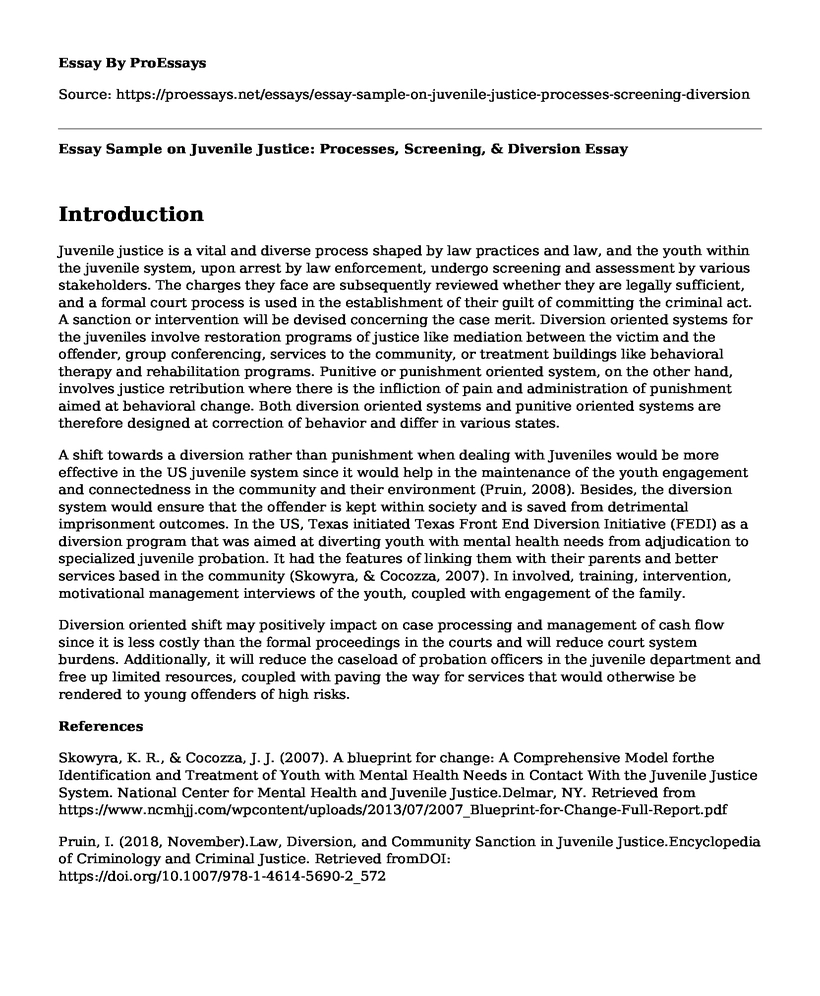Introduction
Juvenile justice is a vital and diverse process shaped by law practices and law, and the youth within the juvenile system, upon arrest by law enforcement, undergo screening and assessment by various stakeholders. The charges they face are subsequently reviewed whether they are legally sufficient, and a formal court process is used in the establishment of their guilt of committing the criminal act. A sanction or intervention will be devised concerning the case merit. Diversion oriented systems for the juveniles involve restoration programs of justice like mediation between the victim and the offender, group conferencing, services to the community, or treatment buildings like behavioral therapy and rehabilitation programs. Punitive or punishment oriented system, on the other hand, involves justice retribution where there is the infliction of pain and administration of punishment aimed at behavioral change. Both diversion oriented systems and punitive oriented systems are therefore designed at correction of behavior and differ in various states.
A shift towards a diversion rather than punishment when dealing with Juveniles would be more effective in the US juvenile system since it would help in the maintenance of the youth engagement and connectedness in the community and their environment (Pruin, 2008). Besides, the diversion system would ensure that the offender is kept within society and is saved from detrimental imprisonment outcomes. In the US, Texas initiated Texas Front End Diversion Initiative (FEDI) as a diversion program that was aimed at diverting youth with mental health needs from adjudication to specialized juvenile probation. It had the features of linking them with their parents and better services based in the community (Skowyra, & Cocozza, 2007). In involved, training, intervention, motivational management interviews of the youth, coupled with engagement of the family.
Diversion oriented shift may positively impact on case processing and management of cash flow since it is less costly than the formal proceedings in the courts and will reduce court system burdens. Additionally, it will reduce the caseload of probation officers in the juvenile department and free up limited resources, coupled with paving the way for services that would otherwise be rendered to young offenders of high risks.
References
Skowyra, K. R., & Cocozza, J. J. (2007). A blueprint for change: A Comprehensive Model forthe Identification and Treatment of Youth with Mental Health Needs in Contact With the Juvenile Justice System. National Center for Mental Health and Juvenile Justice.Delmar, NY. Retrieved from https://www.ncmhjj.com/wpcontent/uploads/2013/07/2007_Blueprint-for-Change-Full-Report.pdf
Pruin, I. (2018, November).Law, Diversion, and Community Sanction in Juvenile Justice.Encyclopedia of Criminology and Criminal Justice. Retrieved fromDOI: https://doi.org/10.1007/978-1-4614-5690-2_572
Cite this page
Essay Sample on Juvenile Justice: Processes, Screening, & Diversion. (2023, Mar 27). Retrieved from https://proessays.net/essays/essay-sample-on-juvenile-justice-processes-screening-diversion
If you are the original author of this essay and no longer wish to have it published on the ProEssays website, please click below to request its removal:
- Essay on BTK Killer: The Public and Media Trial
- Supervision in Criminal Justice: A Law Enforcement Supervisor/Manager as an Effective Leader
- Deaf Rights - Essay Sample
- Hong Kong: Safest City in the Industrialized World - Research Paper
- The Need for Freedom: Locke and Others Contribute to Declaration of Independence - Essay Sample
- Prisoners Receiving Free College Education: Pros & Cons - Essay Sample
- Paper Example on Online Child Sexual Abuse: An Increasing Global Epidemic







